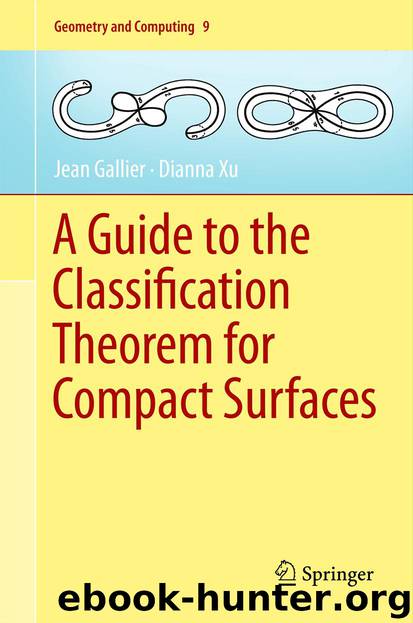A Guide to the Classification Theorem for Compact Surfaces by Jean Gallier & Dianna Xu

Author:Jean Gallier & Dianna Xu
Language: eng
Format: epub
Publisher: Springer Berlin Heidelberg, Berlin, Heidelberg
We may still have several faces. We claim that if there are at least two faces, then for every face, A, there is some face, B, such that B ≠ A, , and there is some edge, a, both in the boundary of A and in the boundary of B. If this was not the case, there would be some face, A, such that for every face, B, such that B ≠ A and , every edge, a, in the boundary of B does not belong to the boundary of A. Then, every inner edge, a, occurring in the boundary of A must have both of its occurrences in the boundary of A, and of course, every boundary edge in the boundary of A occurs once in the boundary of A alone. But then, the cell complex consisting of the face A alone and the edges occurring in its boundary would form a proper subsystem of K, contradicting the fact that K is connected.
Thus, if there are at least two faces, from the above claim and using (P2) − 1, we can reduce the number of faces down to one. It is a simple matter to check that no new vertices are introduced and that loops are unaffected.
Next, if some boundary contains two occurrences of the same edge, a, i.e., it is of the form, aXaY , where X, Y denote strings of edges, with X, Y ≠ ε, we show how to make the two occurrences of a adjacent. Symbolically, we show that the following pseudo-rewrite rule is admissible:
Download
This site does not store any files on its server. We only index and link to content provided by other sites. Please contact the content providers to delete copyright contents if any and email us, we'll remove relevant links or contents immediately.
| Algebraic Geometry | Analytic Geometry |
| Differential Geometry | Non-Euclidean Geometries |
| Topology |
Modelling of Convective Heat and Mass Transfer in Rotating Flows by Igor V. Shevchuk(6349)
Weapons of Math Destruction by Cathy O'Neil(6077)
Factfulness: Ten Reasons We're Wrong About the World – and Why Things Are Better Than You Think by Hans Rosling(4618)
Descartes' Error by Antonio Damasio(3183)
A Mind For Numbers: How to Excel at Math and Science (Even If You Flunked Algebra) by Barbara Oakley(3179)
Factfulness_Ten Reasons We're Wrong About the World_and Why Things Are Better Than You Think by Hans Rosling(3158)
TCP IP by Todd Lammle(3095)
Applied Predictive Modeling by Max Kuhn & Kjell Johnson(2976)
Fooled by Randomness: The Hidden Role of Chance in Life and in the Markets by Nassim Nicholas Taleb(2966)
The Tyranny of Metrics by Jerry Z. Muller(2950)
The Book of Numbers by Peter Bentley(2872)
The Great Unknown by Marcus du Sautoy(2609)
Once Upon an Algorithm by Martin Erwig(2538)
Easy Algebra Step-by-Step by Sandra Luna McCune(2535)
Lady Luck by Kristen Ashley(2493)
Practical Guide To Principal Component Methods in R (Multivariate Analysis Book 2) by Alboukadel Kassambara(2444)
Police Exams Prep 2018-2019 by Kaplan Test Prep(2438)
All Things Reconsidered by Bill Thompson III(2325)
Linear Time-Invariant Systems, Behaviors and Modules by Ulrich Oberst & Martin Scheicher & Ingrid Scheicher(2301)
